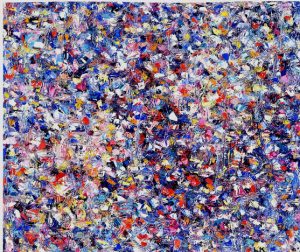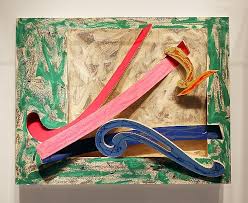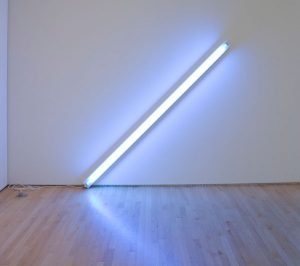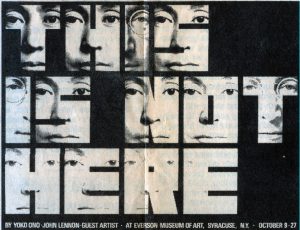So many different styles, so little time!
Introduction Mid Modern Transcript (PDF)
- Abstract Expressionism
- Abstract sculpture
- Assemblages — Found art
- Pop Art
- Op Art
- Minimal Art
- Photorealism
- Conceptual Art
Abstract Expressionism
Abstract Expressionism
Required Link above
- Inspired in part by Existentialism
- Began with a group of WPA artists
- Absence of subject matter
- Focus on the experience of the artist painting
Is abstract art confusing? (optional link)
Jackson Pollock (American) 1912-56 (optional link)
-
- Studied with Thomas Hart Benton
- “Drip’ paintings
- His style became known as action painting
- The paintings convey the actual “action’ of the painter
- His paintings look accidental, but they have planned elements
- There is no obvious top or bottom to a work, it is only designated by Pollock’s signature.
- Popular Work — Lavender Mist
Required Video
How Jackson Pollack painted
Lee Krasner (American) 1908-84 (optional link)
- Married to Jackson Pollock
- Her style is more controlled
- Paint is applied with a brush
- Both Krasner and Pollock influenced each other
- Popular work – Icarus
Willem de Kooning (Dutch) 1904-97 (optional link)
- Career in America
- Like Pollock, his was interested in the action of the painter
- His works contain fragments of subject matter
- Popular work — Excavation (1950)
Mark Rothko (Latvia) 1903-70 (optional link)
- Career in America
- Color field abstractions
- Worked with thin layers of paint
- Film, luminous, floating fields of color
- The desire of the artist was to evoke an emotional response “tragic and timeless’
- Popular Work – Red, Brown, and Black (1958)
My take on Rothko – (optional)
Helen Frankenthaler (American) 1928 — 2011 (optional link)
Frankenthaler Transcript (PDF)
- Similar to Rothko’s color field painting
- Like Pollock, she had to work on the floor
- Poured thinned paints on raw canvas
- Her style was called stain painting.
- Popular Work — The Bay (1963)
Abstract Expressionism
Required Link above
- Inspired in part by Existentialism
- Began with a group of WPA artists
- Absence of subject matter
- Focus on the experience of the artist painting
Is abstract art confusing? (optional link)
Jackson Pollock (American) 1912-56 (optional link)
-
- Studied with Thomas Hart Benton
- “Drip’ paintings
- His style became known as action painting
- The paintings convey the actual “action’ of the painter
- His paintings look accidental, but they have planned elements
- There is no obvious top or bottom to a work, it is only designated by Pollock’s signature.
- Popular Work — Lavender Mist
Required Video
How Jackson Pollack painted
Lee Krasner (American) 1908-84 (optional link)
- Married to Jackson Pollock
- Her style is more controlled
- Paint is applied with a brush
- Both Krasner and Pollock influenced each other
- Popular work – Icarus
Willem de Kooning (Dutch) 1904-97 (optional link)
- Career in America
- Like Pollock, his was interested in the action of the painter
- His works contain fragments of subject matter
- Popular work — Excavation (1950)
Mark Rothko (Latvia) 1903-70 (optional link)
- Career in America
- Color field abstractions
- Worked with thin layers of paint
- Film, luminous, floating fields of color
- The desire of the artist was to evoke an emotional response “tragic and timeless’
- Popular Work – Red, Brown, and Black (1958)
My take on Rothko – (optional)
Helen Frankenthaler (American) 1928 — 2011 (optional link)
Frankenthaler Transcript (PDF)
- Similar to Rothko’s color field painting
- Like Pollock, she had to work on the floor
- Poured thinned paints on raw canvas
- Her style was called stain painting.
- Popular Work — The Bay (1963)
Sculpture
Sculpture
Alexander Calder (American) 1898-1976 (optional link)
- Started as a toy maker
- Caught the attention of Dada and Surrealist artists with this miniature circus
- Created the mobile
- The mobile is a fusion of color, shape, composition time, motion space and relationships
- Popular Work – Untitled (1973)
Isamu Noguchi (Japanese-American) 1904-88 (optional link)
- Studied with Early Modern sculpture, Brancusi
- Incorporated Japanese approach — wabi — the ultimate naturalness of an object
- Also designed furniture and created the first “Akari’ paper lantern
- Popular Work – Kouros (1944-45)
Assemblages or Found Art
An assemblage is a three dimensional work of art that is created from items that were originally created with some other purpose.
Robert Rauschenberg (American) 1925-2008 (optional link)
- A student at Black Mountain College
- Influenced by composer John Cage
- Created with materials that might otherwise be thrown away
- Called his works “combines’
- Did many different types of works, included collaborations with others at Black Mountain College
- Popular Work — Monogram (1955-1959)
Louise Nevelson (American) 1899-1988
- Russian born
- Studied many different types of art — printmaking, theatre, dance, music, painting
- Began assembling furniture scraps in her 50’s
- Her assemblages resemble relief sculptures
- They are always painted in a single solid color
- Popular Work — Sky Cathedral (1958)
Sculpture
Alexander Calder (American) 1898-1976 (optional link)
- Started as a toy maker
- Caught the attention of Dada and Surrealist artists with this miniature circus
- Created the mobile
- The mobile is a fusion of color, shape, composition time, motion space and relationships
- Popular Work – Untitled (1973)
Isamu Noguchi (Japanese-American) 1904-88 (optional link)
- Studied with Early Modern sculpture, Brancusi
- Incorporated Japanese approach — wabi — the ultimate naturalness of an object
- Also designed furniture and created the first “Akari’ paper lantern
- Popular Work – Kouros (1944-45)
Assemblages or Found Art
An assemblage is a three dimensional work of art that is created from items that were originally created with some other purpose.
Robert Rauschenberg (American) 1925-2008 (optional link)
- A student at Black Mountain College
- Influenced by composer John Cage
- Created with materials that might otherwise be thrown away
- Called his works “combines’
- Did many different types of works, included collaborations with others at Black Mountain College
- Popular Work — Monogram (1955-1959)
Louise Nevelson (American) 1899-1988
- Russian born
- Studied many different types of art — printmaking, theatre, dance, music, painting
- Began assembling furniture scraps in her 50’s
- Her assemblages resemble relief sculptures
- They are always painted in a single solid color
- Popular Work — Sky Cathedral (1958)
Pop Art
Above video link is required.
Art created from the materials of everyday life — a soup can, a comic, magazines, iconic images. Insert sound clip Pop Art
Andy Warhol (American) 1928-87 (optional link)
- Became an icon of popular culture
- Defined the Pop Art style
- Started as a graphic artist
- His work contains images of mass marketing
- Campbell’s Soup
- Coca-Cola
- Dollar bills
- Images of Elvis, and Marilyn Monroe
- Called his studio The Factory
- Collaborated with other younger artists — Basquiat and Haring
- Popular Work: Campbell Soup 1
Roy Lichtenstein 1923 — 1997 (optional link)
- Imitated comic strips on a large scale
- Faux ben-day dot is the basis of his style (optional link)
- His works feature 2 kinds of comics: War comics and Romance comics
- Popular Work – Drowning Girl (1963)
Claes Oldenburg and Coosje Van Bruggen (American) 1929 — ? (optional link)
- Born in Sweden
- Later works with his spouse Van Bruggen
- Sculptural works of everyday items
- Whimsical works
- Known for museum-sized sculptures of everyday objects depicted in strange materials, like a cheeseburger made of plaster, and a typewriter sculpted from soft foam.
- Colossal outdoor sculptures that are huge monuments of everyday objects — clothespin, scissors, trowels, spoons
- Popular work 1 — Cheeseburgers with Everything (Dual Hambergers) (1962)
- Popular work 2 — Spoonbridge and Cherry (1985)
Other Pop artists – Optional links
Marisol Escobar (French-born American) 1930
Keith Haring (American) 1958-1990
Robert Indiana (American) 1928- Note – be sure to look at his sculptures.
Op Art
Op Art
Optical art, or Op Art is a style of art that is concerned with how the eye perceives things. Op art frequently plays a trick upon your eye. Op art is meticulously crafted in precise lines or geometric shapes that are colored, or in black, white and gray. These works are intellectual, but they are even more fun in person than in a
photograph.
Op Artists
Optional Links below
Victor Vasarely Hungarian-French (1906-1997)
Bridget Riley British (1931-)
M. C. Escher (1898-1972)
Minimal Art
Minimal Art
‘What you see, is what you see’ Frank Stella (American) 1936 – ?
Minimal art was born out of universities instead of artists gathering in coffee shops or hanging out at the studio. It is clean, exact and bare bones. It truly is very little.
Photo Realism
Photorealism
Required video below.
Optional links below
- Chuck Close American (b. 1940)
- Ralph Goings American (b. 1923)
- Audrey Flack American (b. 1931)
- Duane Hanson American (1925-1996)
Conceptual Art
Conceptual Art –
Required link – browse the article and collection of conceptual art.
Conceptual Art Transcript (PDF)
Out of the tradition of Marcel Duchamp’s Fountain, conceptual art is radical, in that it is frequently an idea, turned into art. It could be something simple like Rocks Upon the Beach Sand Upon the Rocks by Lawrence Weiner, or Diagonal of May 25, 1962 by Dan Flavin. It can also be more complicated and technical.
Conceptual Artists – optional links
Lawrence Weiner American (1942 – )
Rebecca Horn German (1942)
Marcel Broodthaers Belgian (1924-76)
Fluxus
Fluxus
Fluxus was an interdisciplinary, multi-national collection of artists that were highly experimental and creative. The group included visual artist, musicians, designers, and architects, but also included theologians and mathematicians. Like their Dada predecessors, they were anti-establishment art and embraces the absurd. Out of their work, video art was invented and credited to Nam June Paik.
Required Video – Fluxus, a Short Documentary
Optional links to artists below
Above video link is required.
Art created from the materials of everyday life — a soup can, a comic, magazines, iconic images. Insert sound clip Pop Art
Andy Warhol (American) 1928-87 (optional link)
- Became an icon of popular culture
- Defined the Pop Art style
- Started as a graphic artist
- His work contains images of mass marketing
- Campbell’s Soup
- Coca-Cola
- Dollar bills
- Images of Elvis, and Marilyn Monroe
- Called his studio The Factory
- Collaborated with other younger artists — Basquiat and Haring
- Popular Work: Campbell Soup 1
Roy Lichtenstein 1923 — 1997 (optional link)
- Imitated comic strips on a large scale
- Faux ben-day dot is the basis of his style (optional link)
- His works feature 2 kinds of comics: War comics and Romance comics
- Popular Work – Drowning Girl (1963)
Claes Oldenburg and Coosje Van Bruggen (American) 1929 — ? (optional link)
- Born in Sweden
- Later works with his spouse Van Bruggen
- Sculptural works of everyday items
- Whimsical works
- Known for museum-sized sculptures of everyday objects depicted in strange materials, like a cheeseburger made of plaster, and a typewriter sculpted from soft foam.
- Colossal outdoor sculptures that are huge monuments of everyday objects — clothespin, scissors, trowels, spoons
- Popular work 1 — Cheeseburgers with Everything (Dual Hambergers) (1962)
- Popular work 2 — Spoonbridge and Cherry (1985)
Other Pop artists – Optional links
Marisol Escobar (French-born American) 1930
Keith Haring (American) 1958-1990
Robert Indiana (American) 1928- Note – be sure to look at his sculptures.
Op Art
Op Art
Optical art, or Op Art is a style of art that is concerned with how the eye perceives things. Op art frequently plays a trick upon your eye. Op art is meticulously crafted in precise lines or geometric shapes that are colored, or in black, white and gray. These works are intellectual, but they are even more fun in person than in a
photograph.
Op Artists
Optional Links below
Victor Vasarely Hungarian-French (1906-1997)
Bridget Riley British (1931-)
M. C. Escher (1898-1972)
Minimal Art
Minimal Art
‘What you see, is what you see’ Frank Stella (American) 1936 – ?
Minimal art was born out of universities instead of artists gathering in coffee shops or hanging out at the studio. It is clean, exact and bare bones. It truly is very little.
Photo Realism
Photorealism
Required video below.
Optional links below
- Chuck Close American (b. 1940)
- Ralph Goings American (b. 1923)
- Audrey Flack American (b. 1931)
- Duane Hanson American (1925-1996)
Conceptual Art
Conceptual Art –
Required link – browse the article and collection of conceptual art.
Conceptual Art Transcript (PDF)
Out of the tradition of Marcel Duchamp’s Fountain, conceptual art is radical, in that it is frequently an idea, turned into art. It could be something simple like Rocks Upon the Beach Sand Upon the Rocks by Lawrence Weiner, or Diagonal of May 25, 1962 by Dan Flavin. It can also be more complicated and technical.
Conceptual Artists – optional links
Lawrence Weiner American (1942 – )
Rebecca Horn German (1942)
Marcel Broodthaers Belgian (1924-76)
Fluxus
Fluxus
Fluxus was an interdisciplinary, multi-national collection of artists that were highly experimental and creative. The group included visual artist, musicians, designers, and architects, but also included theologians and mathematicians. Like their Dada predecessors, they were anti-establishment art and embraces the absurd. Out of their work, video art was invented and credited to Nam June Paik.
Required Video – Fluxus, a Short Documentary
Optional links to artists below
Minimal Art
‘What you see, is what you see’ Frank Stella (American) 1936 – ?
Minimal art was born out of universities instead of artists gathering in coffee shops or hanging out at the studio. It is clean, exact and bare bones. It truly is very little.
Photo Realism
Photorealism
Required video below.
Optional links below
- Chuck Close American (b. 1940)
- Ralph Goings American (b. 1923)
- Audrey Flack American (b. 1931)
- Duane Hanson American (1925-1996)
Conceptual Art
Conceptual Art –
Required link – browse the article and collection of conceptual art.
Conceptual Art Transcript (PDF)
Out of the tradition of Marcel Duchamp’s Fountain, conceptual art is radical, in that it is frequently an idea, turned into art. It could be something simple like Rocks Upon the Beach Sand Upon the Rocks by Lawrence Weiner, or Diagonal of May 25, 1962 by Dan Flavin. It can also be more complicated and technical.
Conceptual Artists – optional links
Lawrence Weiner American (1942 – )
Rebecca Horn German (1942)
Marcel Broodthaers Belgian (1924-76)
Conceptual Art –
Required link – browse the article and collection of conceptual art.
Conceptual Art Transcript (PDF)
Out of the tradition of Marcel Duchamp’s Fountain, conceptual art is radical, in that it is frequently an idea, turned into art. It could be something simple like Rocks Upon the Beach Sand Upon the Rocks by Lawrence Weiner, or Diagonal of May 25, 1962 by Dan Flavin. It can also be more complicated and technical.
Conceptual Artists – optional links
Lawrence Weiner American (1942 – )
Rebecca Horn German (1942)
Marcel Broodthaers Belgian (1924-76)
Fluxus
Fluxus
Fluxus was an interdisciplinary, multi-national collection of artists that were highly experimental and creative. The group included visual artist, musicians, designers, and architects, but also included theologians and mathematicians. Like their Dada predecessors, they were anti-establishment art and embraces the absurd. Out of their work, video art was invented and credited to Nam June Paik.
Required Video – Fluxus, a Short Documentary
Optional links to artists below
Fluxus
Fluxus was an interdisciplinary, multi-national collection of artists that were highly experimental and creative. The group included visual artist, musicians, designers, and architects, but also included theologians and mathematicians. Like their Dada predecessors, they were anti-establishment art and embraces the absurd. Out of their work, video art was invented and credited to Nam June Paik.
Required Video – Fluxus, a Short Documentary
Optional links to artists below








Pingback: Middle Modern: The Multifaceted Styles of Sculpture – Drosales51